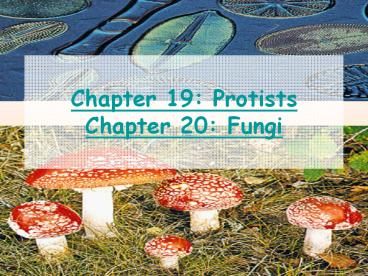Chapter 19: Protists Chapter 20: Fungi - PowerPoint PPT Presentation
1 / 16
Title:
Chapter 19: Protists Chapter 20: Fungi
Description:
Chapter 19: Protists Chapter 20: Fungi Chapter 19 Objectives Identify the characteristics of Kingdom Protista. Compare and contrast the different groups of protists. – PowerPoint PPT presentation
Number of Views:500
Avg rating:3.0/5.0
Title: Chapter 19: Protists Chapter 20: Fungi
1
Chapter 19 ProtistsChapter 20 Fungi
2
- Chapter 19
- Objectives
- Identify the characteristics of Kingdom Protista.
- Compare and contrast the different groups of
protists.
3
- Characteristics
- Eukaryotes
- Live in moist environments
- Unicellular or multicellular
- Autotrophs, heterotrophs, or both
- Some move - others cannot
- 3 categories of protists
- Animal-like
- Fungus-like
- Plant-like
4
- Animal-like Protists
- called Protozoans
- unicellular heterotrophs
- four groups based on movement
- Pseudopods
- Flagellates
- Ciliates
- Others
5
- Psuedopods
- false feet
- used for movement (cytoplasmic streaming) and
feeding - thin cell membrane
- contractile vacuoleexpels excess water
- reproduce by mitosis
- Example Amoeba
6
- Flagellates
- called Zooflagellates
- move by a flagellum
- these usually live inside other organisms
- Examples termites
- African sleeping Sickness
7
- Ciliates
- cilia
- help organisms move, get food and sense
environment - multicellular with 2 nuclei
- macronucleus controls everyday functions
- micronucleus is for reproduction.
- reproduce by mitosis or
- conjugation
- Example Paramecium
8
CONTRACTILE VACUOLE
CILIA
FOOD VACUOLE
MACRONUCLEUS
MICRONUCLEUS
ORAL GROOVE
ANAL PORE
9
- Other Protozoans
- called sporozoans - parasites
- feed on cells body fluids of hosts
Sporozoans like Plasmodium (causes malaria) have
more than 1 host mosquitoes and then humans
10
- Fungus-like Protists
- heterotrophs
- cell walls
- reproduce by spores (tiny cells that can grow
into a new organism) - move at one point during their lives
- Examples Water or Slime molds
11
- Plant-like Protists
- algae
- autotrophs
- unicellular
- contain different pigments so they come in
different colors - Euglena special type of algae
- when there is no sunlight they become
heterotrophic
12
- Chapter 20Fungi
- Objectives
- Describe the basic characteristics of the fungi
kingdom - Explain the role of fungi as decomposers
13
- Characteristics
- eukaryotes
- use spores to reproduce
- heterotrophs
- need warm, moist places to grow
- have hyphae
- thread-like structures used to obtain food
- Examples yeast, molds, mildew, and mushrooms
14
- Reproduction
- produce spores with a protective covering
carried by water and air (asexual) - can reproduce sexually
- yeasts are unicellular and go through budding
15
- Fungi Groups
- Threadlike - produce spores in their threadlike
hyphae (ex. Bread mold) - Saclike - produce spores in structures that look
like sacs (ex. Yeast)
16
- Clubproduce spores in structures that look like
clubs (ex. Mushrooms) - Imperfectcannot go through sexual reproduction
(ex. Penicillin)































